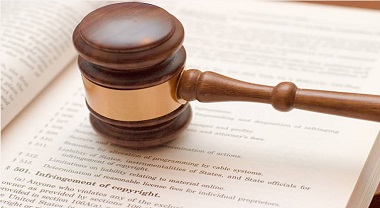Takedown Services Under Copyright Law
The author or creator of any theatrical, literary, creative, or musical work has an exclusive right to copyright. It also allows the owner or creator to replicate the protected work, make it public, change it, and translate it into any other format. It was recently uncovered that numerous internet platforms are posting infringing content on their websites without the approval of the copyright owners. Copyright infringement cases on the internet have increased because the internet has become more widely available. To address these issues, the government has created the Takedown Services for Copyright Protection idea, which allows copyright owners to issue takedown notifications to platforms that are infringing on their rights.
[Image Source: gettyimages]
What are takedown services?
A takedown notice is a type of complaint letter addressed to a website administrator, stating that the website’s material has infringed on the owner’s copyright and requesting that the content be removed from the website. Along with removing the information, they are also required to create a digital fingerprint of it and preserve it in their system so that it cannot be re-posted until the dispute is resolved. An internet service provider, for example, can be any form of online site operator, such as a website operator, web presenter, search engine, or any other type of online site operator.According to copyright law, a takedown notice must include numerous parts, and if any of them are lacking, the service provider has the right to refuse to remove the content that infringes on the owner’s copyright.
The Digital Millennium Copyright Act, 1998, mentions regulations surrounding takedown notices in nations like the United States. In the instance of copyright infringement, the legislation imposes severe penalties while also offering protection to internet service providers and Internet Service Providers (ISPs) based in and listed in the United States, such as YouTube. Previously, unlike the United States, India did not have a particular statute requiring a takedown notice for copyright infringement; instead, it merely had sanctions for copyright infringement.However, as a result of an increase in copyright infringements, India has started issuing takedown notices to middlemen who infringe on the copyright of the owners.
Legal Framework governing take down notice
Copyright is infringed under Section 51 of the Copyright Act, 1957when someone interferes with the owner’s exclusive right and uses it illegally without the owner’s or registrar’s permission.
Temporary or incidental storage of work or performance to provide electronic links, access, or integration, where the owner has not expressly prohibited such links, access, or integration, falls under the ambit of fair use of copyright, according to Section 52(1)(c) of the Indian Copyright Act, 1957. If the person is proven to be responsible for the copy’s storage, the owner of the copyright will send him a written complaint, stating that such temporary or incidental storage is an infringement.The person responsible is also prohibited from advertising access for a period of 21 days or until he receives an order from the court; if the order is not received before the end of the 21-day period, he is permitted to provide such access.
Information Technology Act,2000
The Information Technology Act of 2000 [hereinafter referred to as the “IT Act”] regulates the intermediaries or Internet Service Providers (ISPs) involved. An intermediary, according to the Act, is a person who receives, stores, or distributes a message on behalf of another person or provides any service linked to that message. If the intermediary fails to comply with the government’s takedown request or engages in illegal activity, the protection granted to him may be revoked at any time. Furthermore, neither the intermediary nor the ISP shall be held accountable for any third-party link supplied or given by it.
Although Section 81 of the IT Act specifies that the prohibitions of Section 79 do not preclude anyone from exercising any rights allowed under the Copyright Act 1957, intermediaries are exempted from accountability for copyright infringement. As a result, the IT Act’s obligations have precedence over all other laws. Copyright owners, on the other hand, are barred from exercising their copyright law rights. It states that if there is a direct infringement of copyright by intermediaries, the owners of copyright can take legal action against them.
Safe Harbour Principle ( Section 79 of IT Act,2000)
The safe harbour exemption clause was added to Section 79 of the Information Technology Act of 2000, which protected an intermediary from liability for third-party content on its platform if it completed “due diligence” as specified by the Central Government. Intermediaries who failed to comply with the Central Government’s “due diligence” requirements were held liable for any actions done by third parties, even if they were unaware of them. This issue remained unaffected with the 2008 Amendment, as intermediaries were permitted to continue using the safe harbour principle to prevent themselves from being held accountable for choices made by a third party without their knowledge.
Rules on Information Technology, 2021 (Intermediary Guidelines and Digital Media Ethics Code).
By adopting rules and regulations, as well as a privacy policy, the intermediary must prevent its users from presenting, uploading, changing, or transferring any information that may result in infringement of any trademark, patent, or copyright. In addition, intermediaries are unable to refute the allegations and are required to comply with takedown notices given to him. It stipulates that if an intermediary obtains a court order or is notified by the government or a third party about content infringement, he cannot store or present any illegal information that is prohibited by law. He has 36 hours to act, or he will face severe sanctions.It also enables the intermediary to set up grievance redress systems to deal with complaints. As a result, the intermediary must appoint a Grievance Officer to investigate allegations of rule violations. Within 24 hours of receiving the complaint, the Grievance Officer is supposed to identify it and resolve it within 15 days of receiving it. In addition, social media intermediaries must appoint a Chief Compliance Officer in accordance with the Act and IT Rules. They must submit a monthly compliance report detailing all facts and measures taken to resolve the issues. If the officer is unable to produce any information, he or she will be held accountable.Because IT Rules 2021 are self-explanatory, non-compliance means that intermediaries are accountable for any acts undertaken by third parties, even if they were not aware of them. Because of the severity of the penalties for non-compliance, intermediaries should follow the IT Rules 2021 to avoid penalties and to keep the safe harbour principle, which operates as a virtual barrier, intact. In the future, various intermediaries may raise legal challenges to the legitimacy of the IT Rules 2021 in order to protect their autonomy and authority.
Howto file a Takedown Notice in India?
An owner or holder of Copyright is required to make a notice to the intermediary whose website displays or permits access to infringing or pirated work under Section 52 (1)(c) of the Copyright Act, 1957. The fundamentals of takedown and the process of giving it are laid forth in Rule 75 of the Copyright Rules [2013]. While drafting the Takedown Notice, keep the following in mind:
- The description should be sufficient to identify the work. To stand out among the many comparable contents produced on the internet every day, the description must be specific and not ambiguous. Before a copyright-protected item can be taken from a website like Facebook or YouTube, it must be clearly identified.
- A violating copy of the work, whether brief or extra storage, should be owned by the complainant and not indicated under Section 52 or any other section of the Copyright Act [1957].
- Information on the person who commits the offence by downloading the owner’s work and so infringing on their Copyright.
- The complainant is the sole Copyright owner of the work, according to the details. As a licensee, your complaint should include a copy of your licence agreement as well as the Copyright Takedown Notice.
- The location of all of the work’s details. A URL or link to the infringing work should be included in the Copyright Takedown notification. If a website has a link or URL, the server can immediately delete it.
- Assuring that the complainant files an infringement lawsuit in the appropriate court against the person responsible for publishing the infringed content or work, as well as obtaining orders from the court with jurisdiction, within 21 days of receiving the notice.
In India, the notification must be sent only after the Copyright owner consults with a Copyright lawyer to fully understand the legal process and ensure that a strong case is made that does not fall under Section 52 of the Copyright Act [1957].
Furthermore, the Copyright Rules state that as soon as the individual responsible for the storage of the violated copy of the original work receives the complaint, he is required to remove the violated content within 36 hours and to take vital measures to prevent access for the same for 21 days from the complaint’s receipt date or until they receive an order restraining them from giving access from the appropriate court, whichever comes first.
Cases
Following are some famous examples of Takedown services for Copyright Protection:
- Union of India vs Shreya Singhal (2013) 12 S.C.C. 73: One of the questions before the Supreme Court in this case was whether Section 19 of the Information Technology Act is constitutionally legitimate for Article 19 of the Constitution or not. The court held that if the Section’s requirements are implemented, met is immune from liability. By looking at Section 79 (3)(b) and Rule 3, we can conclude that the knowledge described in this section should only be obtained through a government agency or a court order.
- Swami Ramdev vs Facebook, Inc. and OthersCS (OS) 27/2019: In this case, defendants Facebook, Google, Twitter, and YouTube were ordered to remove URLs that were allegedly insulting to the plaintiffs from their relevant platforms. Swami Ramdev made the motion, claiming that defamatory content and videos about the book “Godman to Tycoon” were put on the defendant’s site. After analyzing the law on intermediary liability under the IT Act, 2000 and IT Rules, 2011, the Delhi HC (High Court) ruled that the intermediaries must remove and prohibit all such illegal content and movies submitted on their platform from IP addresses in India. They were told to utilize geo-blocking software and stop content watching for stuff published outside of India.
- MySpace Inc. v. Super Cassettes Industries Ltd. (SCIL) (2016)Myspace Inc. is a US-based firm that operates under the Digital Millennium Copyright Act (DMCA), thereby adhering to the “Notice and Take Down” idea. It is a website that allows users to view, upload, and share movies, music, and other media for entertainment purposes. According to the responses, the content posted on the site was infringing. Despite the warning, they continued to broadcast the content on the website, infringing on SCIL’s copyright. The Delhi High Court ruled that the site was accountable, and that the copyright-infringing content had to be removed within 36 hours of “real knowledge” of the infringement.
- Christian Louboutin SAS v. Nakul Bajaj (2018)
In this case, the plaintiff sued Darveys.com, a website that sells imported luxury items, on the grounds that it was selling counterfeit and defective products that infringed on the plaintiff’s trademark. The High Court of Delhi, acting as an active participant in the transaction, identified the website as an intermediary and held it accountable for trademark infringement, stating that claiming refuge under the IT Act’s safe harbour provisions is not permitted.
Conclusion
The owner has the unique right to issue a Takedown Notice to digital platforms under Section 52 (1)(c) of the Copyright Act, asking them to remove infringing content from their website as soon as possible. Previously, the intermediary’s duty to Copyright owners was secondary, and if the court’s order was not followed, the intermediary was not liable. However, this is no longer the case. In terms of copyright protection and takedown services, the new IT laws have given content creators a lot of hope because, in the event of infringement, they can directly file a complaint with the Grievance Officer, who will promptly resolve the matter.In the prior regime, the intermediary’s duty to copyright holders was secondary, and the intermediary was only accountable if the copyright holders did not comply with the court order.
Author: Anuja Saraswat- a student of NMIMS Kirit P. Mehta School of Law (Mumbai), in case of any queries please write back us via email at support@ipandlegalfilings.com or contact us at IP And Legal Filings.




